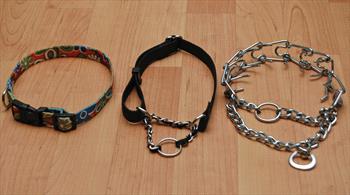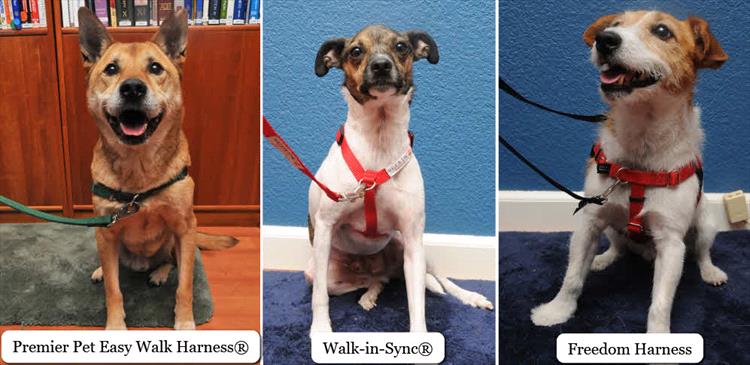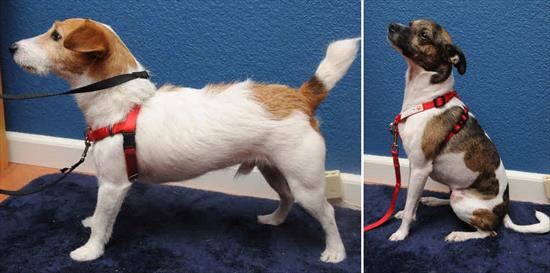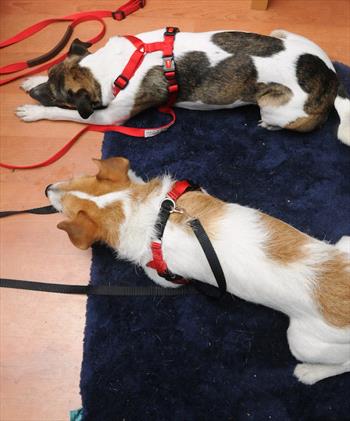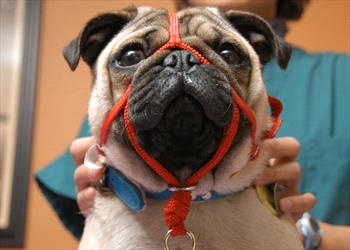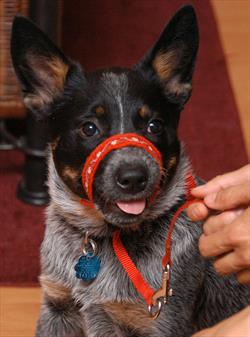Dogs come in to the veterinary hospital and to our various handling labs wearing a variety of collars and harnesses. While all of these collars and harnesses are sold online or in stores, some are not necessarily healthy or safe for all dogs. In this article, I provide a summary of the pros and cons of some of the various collars and harnesses for dogs.
- Rolled or flat collars
- Martingales
- Choke chains
- Pinch collars
- Front-attaching harnesses: Easy Walk Harness, Walk-in-Sync Harness, Freedom Harness.
- Head halters: Gentle Leader, Snootloop
Flat and Rolled Collars
By far the most common collar is the flat or rolled collar that fastens with a plastic clip or a buckle. These collars are the most convenient to slip on and off and are handy because they can hold your dog’s identification, rabies, and license tags. Even though this type of collar retains its size, the collar can become a hazard. Dogs playing roughly and in a mouthy manner can get their mouth caught in the collar of another dog, causing panic in one or both dogs. As they struggle to get loose, the collar can tighten and dogs have suffocated as a result of this type of play. Dogs who are the object of this type of rough play should wear break-away collars, similar to the break-away collars in cats, at least during play and unsupervised times. Some owners opt to avoid collars or any gear at all unless they are taking their dog on a walk. Although this in an option, I prefer to have visible identification on my dog at all times and a collar with its tags is the most convenient way to do this.
A second downside to this type of collar is that according to a study in the Journal of the American Animal Hospital Association in 2006, pressure generated when dogs pull while wearing these collars raises the pressure in the eye. As a result, it may worsen the clinical signs or disease progression in dogs with glaucoma, thin corneas, and other eye conditions where the pressure in the eye is an issue. So dogs who have or are prone to any of these conditions should either be trained via a non-force-based method to walk on loose leash and never pull or they should wear a harness or halter type of collar (which we cover below).
Choke Chains
When I started training dogs over 20 years ago virtually all dogs who were in training wore choke chains. Although I used choke chains for many years I never use them now that I have a better and more effective set of skills. Before I tell you why, let me first explain how a choke chain is used.
The traditional way these chains are used by professional trainers is to give a sharp jerk—strong enough to make the dog stop what it’s doing and do something else. For instance, if the dog starts to sniff and pull on a walk, you quickly brace yourself and give a quick yank in the hopes that the dog feels it enough to stop pulling. My first trainer told us to generate enough strength by actually running full speed in the opposite direction so that my, then 76 pound boxer, would feel a strong enough pop! The next trainer I had taught me to first attach the leash to a fence so that I could practice the technique and get it right before I tried it on the dog. The technique was a lot like karate where you have to twist your hip to get enough power for your body and so that you can get the timing of the correction right. Most trainers do not give owners practice on a fence first. They just let owners make a lot of mistakes on the dog.
With the choke chain, the idea is that once the dog knows he’ll get a strong correction when he misbehaves, you don’t need to continue to give strong corrections often; a light correction, may be good enough because it’s a reminder that a stronger, more painful correction can occur. In fact, it’s this phenomenon, with the use of a lighter warning correction that makes some people think that it’s the sound of the collar being jerked that teaches the dog, as if there’s something innately aversive about the sound. If that were true, then you’d be able to train dogs with a recording of the sound of a choke chain snapping, even if the dog had never received a choke chain correction before and was not sound sensitive. In other words, if that were true, someone who could have developed a little device that dogs can wear on their leash or flat collar that makes the sound of a choke chain snapping would be rich!
Another fact about the choke chain is that most people use them ineffectively because they are not that easy to use and there are some secrets that the old time professionals used to make them more effective and the correction stronger. First, these professionals make sure the length is right or you won’t get the strong, quick pop. If the chain’s too long, when you go to give a correction, there’s too much slack. When it’s too short, the collar tightens too quickly, before you’ve gained enough momentum in the jerk. Seasoned trainers also know that dog’s feel the correction more if you can keep the choke chain up high, right behind the ears. That’s how Cesar Milan’s Illusion collar works. It keeps the collar positioned so that a correction can have the greatest effect (e.g. create the most effective jerk). Back when I was competing in obedience we didn’t have Illusion collars and they wouldn’t be allowed in the ring now anyway, but we did try to keep that choke chain up high when we were training. A third point, but one that’s the first thing a seasoned professional trains is that the choke chain has to go on the right way. It needs to form a “P,” with the tail of the “P” on the same side as the handler. You can tell right away when a force-based trainer isn’t good at his choke chain technique because he doesn’t even put the collar on correctly.
So why do I avoid the choke chain? Besides the fact that my philosophy of training is to focus on rewarding the dog’s good behaviors and removing rewards for unwanted ones until the dog forms good habits, there are many medical and safety reasons too. Not surprisingly, strong yanking on the neck with a chain can cause health issues. If the force from a dog pulling on a flat collar raises intraocular pressure, imagine how high that pressure must rise when you actually yank the dog with a thin chain! Even if your dog has no eye issues, the choke chain, is notorious at exacerbating airway issues. For instance it can worsen coughing in dogs prone to collapsing trachea (weak trachea that flatten more than they should) and affect the ability of dogs with small tracheas, such as Pugs and Bulldogs, to breath. Additionally, dogs may develop neurological damage when the corrections are strong enough. The damage, called Horner’s Syndrome, can result in changes to the pupil in the eye and nerve-induced lameness in the front leg. Lastly, even if you don’t use a choke chain in the manner described above, choke chains should never be left on an unsupervised pet. They can get caught on something and tighten to the point where they strangle the panicked dog.
Martingale
Martingale collars are like flat collars but they tighten when the dog pulls. Even though they tighten, they are generally not used for giving a correction the way a choke chain is. Rather, they are used because they are less likely to slip over the dog’s head when adjusted correctly than a flat collar is. These collars should be adjusted so that even at their tightest they cannot accidentally strangle the dog
Pinch Collar (Also known as prong collar)
The pinch collar is almost as old as the choke chain in terms of dog training correction tools. It’s commonly referred to by traditional trainers, as power steering because you don’t have to use as much physical strength to get an effective jerk as you do with a choke chain. Although this product looks to some like a torture device, it may actually be safer in some respect than the choke chain. The pointy parts are spaced out so that the force is spread out across all of them. Overall, pinch collars produce less pressure on the neck when jerked hard compared to the choke chain because the surface area of the pinch collar is greater. If you’re not sure about this, try it on yourself and compare it to the choke chain. You can try it on your arm or your leg. You don’t have to try it on your neck. Although they may cause less pressure around the neck than a choke chain they do still increase pressure so they can still lead to all of the same issues that a flat collar and even a choke chain causes.
Owners who use the pinch collar may not use it with the strong yanks of a professional trainer. The general dog owner tends to just let the dog pull and because pulling is uncomfortable and even painful to the dog, the dog may pull less. Even when the owner does not use the pinch collar to give jerking corrections, there are still some important pitfalls that owners should be aware of. The biggest pitfall is that if the dog is fearful, say of another dog it sees, and it simultaneously feels the pain of the pinch collar, the dog may learn to associated the pain with the dog it fears and become more fearful of dogs. The second pitfall is that if the dog is highly excited, for instance, it wants to play with another dog and is lunging on the leash to reach the dog, the pain or aversive feeling they get from the collar can increase their excitement and arousal level. In other words it can cause them to bark and lunge more!
In case your wondering, I haven’t recommended a pinch collar for any client in over a decade.
The Harness is One Alternative to a Collar
One of the most common alternatives to a collar is a harness. Veterinarians routinely recommend that dogs, such as pugs with their short noses, and miniature poodles with their propensity for collapsing trachea wear harnesses. However, it’s important to chose the right one. In general I avoid harnesses that hook on the back unless you want to train your dog to pull a cart or a sled. These harnesses actually help train your dog to ignore you and pull you because when you pull on the leash to try to gain some control, they direct the dog’s attention away from you.
So I recommend a front-attaching harness. There are several types:
Premier Pet Easy Walk Harness®: This was one of the first front-attaching harnesses on the market. When the dog gets ahead and pulls, it redirects the dog’s attention back to you. So if the dog sees a cat and sprints forward and you decide to head the other way, your movement will help turn the dog around so that he’s facing the direction you want to travel. I routinely recommend this harness for dogs who need more directional control than a flat collar provides; however, for many dogs, this harness can alter their natural gait. It tends to hinder shoulder movement. As a result, I’m more likely to limit its use in dogs that are competing in athletic sports. That same pressure on the shoulder that hinders shoulder movement,can be a benefit in some cases where you might actually need to hinder the dog’s front end. For instance if the dog’s bigger than you and can potentially take you skiing, this harness may help you keep him safe. Another option until you get this type of strong puller better trained is to use a head halter, which is discussed later.
Walk-in-Sync®: This front-attaching harness was introduced more recently and comes with a leash and basic training system. Unlike the Gentle Leader harness, it has a strap that attaches between the front legs and over the back. As a result, it allows for unhindered movement of the shoulders.This makes it a better choice for dogs competing in sports than the Gentle Leader harness. It also provides better directional control than a collar but less directional control than the Gentle Leader Harness. Another factor to consider is that when you try to guide the dog in a new direction, the harness tends to guide from the strap that goes around the base of the neck rather than evenly, even when fitted carefully. This tightening varies based on the dog’s body shape.
Freedom Harness: This front-attaching harness has similarities to both the Easy Walk Harness and the Walk-in-Sync Harness. It has a strap across the front like the Easy Walk but a strap between the legs like the Walk-in-Sync. As a result it provides a little more freedom of movement of the shoulders than the Gentle Leader Harness, but it also provides more directional control than the Walk-in-Sync. Additional control occurs because this harness comes with a leash that attaches to the front and to the back of the dog and when you pull on the leash it tightens the harness around the dog.
Head Halters
I recommend head halters a lot for those owners who want to speed up training and need help keeping their dog’s attention. Once their dogs are trained well enough, they may opt to switch to a different collar or to a harness. I specifically choose head halters that help you guide the dog’s attention towards you rather than those that just keep the dog from extending his head forward. Why would a head halter help? As with horses, the body tends to go where the head is pointing. Plus dogs can best pay attention to their owners if they are actually focusing on their owners, which they can do best if they are looking at their owners. For instance, if a dog sees another dog and wants to pull and lunge, the owner can gently redirect the dog’s attention back to herself and then engage the dog in more appropriate and equally fun behaviors that they have practiced such as run after me and get a treat or play with a toy.
The down-side of the head halter is that you often need to train dogs to enjoy wearing them and, while some dogs automatically walk nicely with the head halter, other dogs and their owners require some training. Most owners who start their dogs correctly on one of these head halters find that the relatively small time investment getting the dogs used to the collar is well worth it. For some dogs that time is only a few seconds to a minute of pairing the head collar with food. For other dogs I recommend a little practice every day for a week so that the owners are sure the dog loves shoving his nose into the halter on his own. (For instructions, use the same process as counter conditioning a dog to love wearing a muzzle).
Once the dog loves putting his nose into the head halter and the owner puts it on, the owner may need to engage the dog in fun behaviors to distract him from the funny object on his face until the dog gets used to it.
The next step in training dogs with a head collar is to train them that when they reach the end of the leash they are going nowhere. That means the owner must hold perfectly still and avoid taking a step or even moving the leash-holding hand. Once the dog figures out that pulling harder does not work and instead steps back or turns to the owner such that the leash is hanging loose, then the owner can resume walking. Better yet, the owner can reward the dog with a treat so that dog comes all the way back to her and then they can resume walking forward. It’s important that the dog learn that a tight leash and the associated pressure created means she should stop. If the dog is not taught this and tends to act impulsively, she may dart out after a cat or other object and hit the end of the leash with some speed. This type of accident could potentially cause neck pain or injury. Even in the emergency situation, if the owner is paying attention, they can prevent neck wrenching if they gradually tighten the leash rather than letting the dog dart forward on a loose leash so that she suddenly hits the end.
Conclusion
So there you have it, an overview of a variety of common collars and harnesses. None is perfect. They are all just tools. But some are more likely to cause problems in your pet or may just provide a less than ideal match for your needs. In case you’re wondering which I prefer—ideally my dog can walk on leash with the flat collar he wears regularly. But for those dogs that tend to pull and need more work, I tend to recommend a front-attaching harness or a head collar of some sort.




